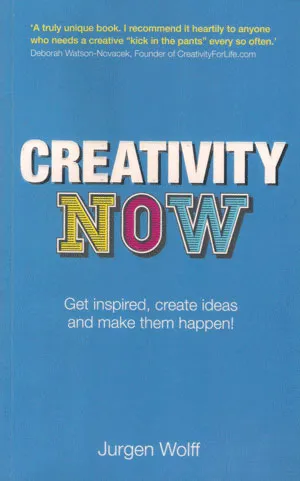[Book Review] Creativity Now: Get Inspired, Create Ideas and Make Them Happen!

2012 Pearson International
224 pages
This book is a useful ‘creativity assistant’ to keep your creative juices flowing, and a good kick in the butt to get you out of your productivity doldrums!
The slender book makes for an easy read, and is full of inspiring photographs, stimulating ideas, inspirational quotes, useful examples and innovative exercises. Each chapter is short, just a page or two in length, with actionable tips and checklists.
The book has an online companion with more tools and tips to keep the creative flow going. Most of the cited examples are from the US and UK, and it would be great for other writers to jump in and expand the discussion with global perspectives too.
Jurgen Wolff is a writer and coach in creativity and writing, who divides his time between London and southern California. His other books include Marketing for Entrepreneurs, Focus, Your Writing Coach, and Do Something Different.
The material is divided into four sections: Dreaming, Originating, Applying and Adapting. I have summarized some of the principles in Table 1, but each section is worth a detailed read of course.
“The journey to creative success is at least as rewarding as arriving,” begins Wolff. He is a strong advocate of the ‘Ready, Fire, Aim’ school of creativity which is in favour of prototyping and adaptation rather than overplanning. “You can fail only if you stop,” he advises; “success is what you say it is.”
Table 1: Creativity Principles
The author describes four key principles of brainstorming: quantity counts (create lots and lots of initial ideas), don’t be judgemental in weeding out ideas, write down every idea, build on others’ ideas. Wolff brings up a useful quote from Linus Pauling in this regard: “I have lots and lots and lots of ideas, and then I throw away the bad ones.”
One whole section of the book is devoted to profiles of companies who embody some of the creativity principles described above: such as i-PostMortem (with virtual i-Tombs as online memorial services after you pass away), Sal Khan (Khan Academy), artists who successfully raised funds from Kickstarter, Jacquie Lawson (e-cards), Simon Tofield (use of YouTube to promote his cat animations), Marco Giannini (healthy dog food), Michael Sands (nutritious non-junk snackfoods), Will Ramsay (Affordable Art Fair), Paul Stanyer (HolidayTaxis.com for hassle-free taxi experiences for tourists), Joanna Wivell (InsidersMadrid.com online tourism service for Spain), Tax and Relax (bed&breakfast offering free tax filing), Moby’s album Play (licensed to TV shows), Todd Basche (travel locks based on words and not numbers), and Tammy Tibbets (ShesTheFirst.org site for fundraising information on women’s causes).
Cited books include Difference (Scott Sage), Guerilla Marketing (Jay Levinson), and The Creative Habit (Twyla Tharp); the Creativity World Forum is also mentioned as an interesting event for creative types. More such events, references and online resources would have been helpful for readers (eg. the book Thinkertoys by Michael Michalko comes to mind).
In sum, this useful and engaging book shows readers how to unleash endless streams of ideas on any topic and how they may be turned into success.
[Follow YourStory's research director Madanmohan Rao]


![[Book Review] Creativity Now: Get Inspired, Create Ideas and Make Them Happen!](https://images.yourstory.com/cs/wordpress/2013/04/cn.jpg?mode=crop&crop=faces&ar=16%3A9&format=auto&w=1920&q=75)




